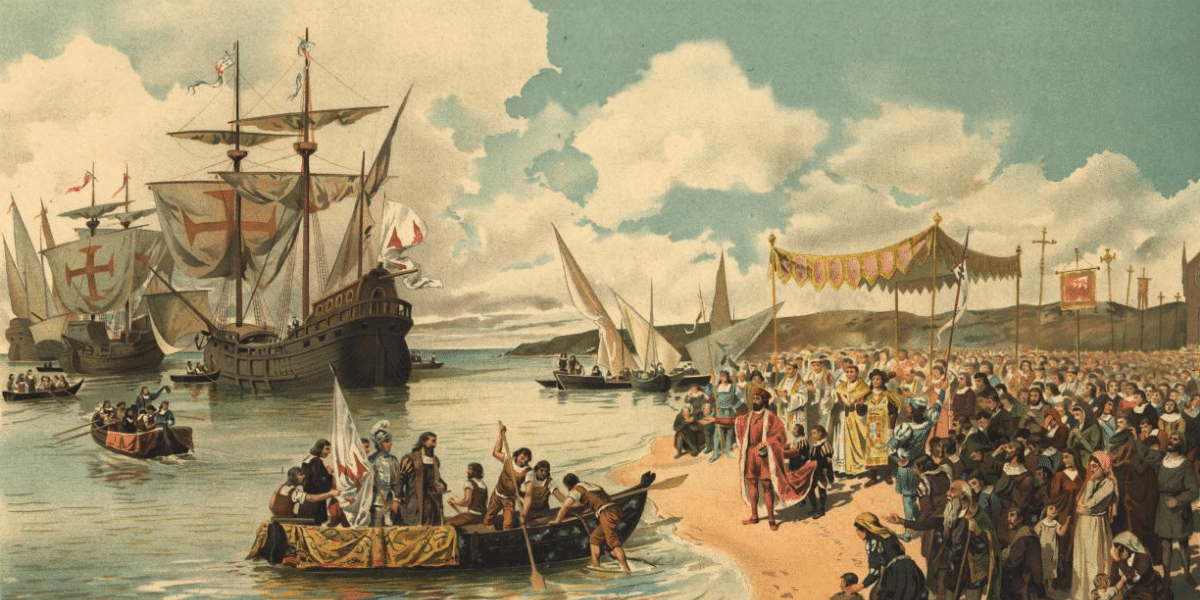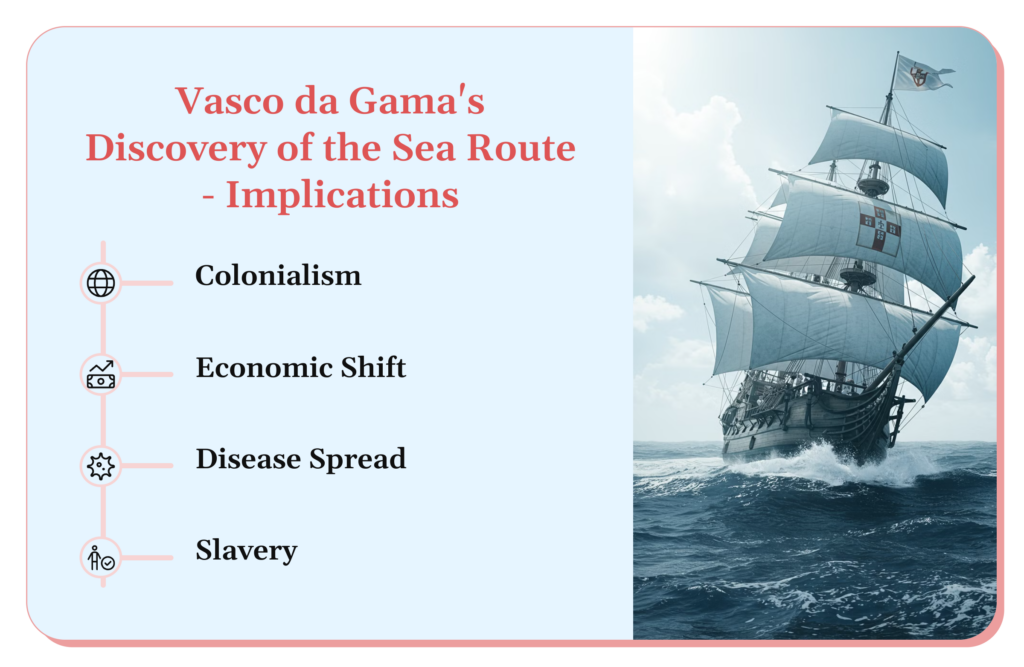
Quick Summary
Table of Contents
Vasco da Gama discovered the sea route to India on May 17, in the year 1498 C.E. was a Portuguese explorer. He came to India during the Age of Exploration. He was in search of the rare Indian spices. These spices were highly valued in European countries. They began to look for new trade routes to India to gain a spice trade monopoly. It led to the development of spice trade in European countries.
Portuguese explorer Vasco da Gama was eventually credited with finding the sea route to India. Under King Manuel I’s reign, this was the first expedition to India documented from Europe. It was considered one of the most significant nautical expeditions and gave the Portuguese a stronghold in Kerala and the Indian Ocean.
Vasco da Gama’s name is boldly written in Indian history textbooks. He made history by discovering the sea route to India from Europe.
Vasco da Gama, born in the 1460s, was a Portuguese explorer. His father, Esteva, was a nobleman who joined the Order of Santiago under the rule of King John II of Portugal. Vasco da Gama followed his father to join the Order of Santiago in 1480.
The Portuguese government was trying to find a sea route to India to avoid the restrictions of Muslim leaders. It was a cost-saving measure to avoid the middleman. Since Indian spices were world-famous, they wanted a monopoly on the spice trade. They saw the potential wealth and power in finding a direct sea route to India. The discovery of the sea route to India was an excellent contribution to making Portugal a powerful country.

The Portuguese monarchy had a vital role in the sea expedition to India. Earlier, King John’s son, Prince Henry, supported numerous sea expeditions. He financed the Western African maritime expeditions. His successful endeavors motivated King Manuel I to support Vasco da Gama.
King Manuel financed the sea expedition to India and provided ships, supplies, and a crew. The monarchs supported maritime expeditions because they benefited their kingdoms.
Ahmad ibn Majid, from a seafaring family and an Arabian navigator born in 1421, assisted Vasco da Gama in his journey from Africa to India. At 17, he became the first Arab seaman known as the ‘Lion of the Sea’.
Ibn Majid was well-known in the maritime industry long before Vasco Da Gama set out on his expedition in the Indian Ocean. To travel from Malindi (Kenya) to India, Vasco da Gama enlists the aid of an Indian Ocean sailor. It is believed that in 1498, Ahmad Ibn Majid gave Portuguese explorer Vasco-da-Gama the route to India while under the influence of alcohol. Nonetheless, many historians also believe that Vasco already had a map created by Ahmad and a Gujarati sailor who had shown him the route to the port of Calicut. At the same time, they were at the port of Malindi (Kenya) on their way back to India.
Even when it wasn’t Ibn Mājid who commanded da Gama’s ship, still, without the collective wisdom that passed across the Indian Ocean thanks to the contributions of Ibn Mājid, Vasco da Gama would not have arrived at his destination.
Vasco da Gama, who discovered the sea route to India, began the Indian voyage preparations in early 1497. The sea expedition to India was a plan originated by King John II, but King Manuel I supervised all the preparations for the expedition.
Vasco da Gama discovered the sea route to India. His departure from Portugal to India led to a historic event. This man started this journey from Lisbon on 8 July 1497. He had four ships with a crew of 170 members. He commanded a ship named St. Gabriel himself. His brother, Paulo, also led one of the ships. The boat was named St. Rafael.
The new ships for the voyage weighed around 170-200 tons each. King Manuel I supervised all the preparations for the Indian Voyage. The distance covered back and forth from Portugal to India was the largest traveled via sea at that time.
As the Portuguese explorers had already explored Africa, they found a way to reach India through the Cape of Good Hope. They believed the Atlantic and Indian Oceans meet at the end of African lands.
Vasco da Gama reached the Cape of Good Hope, located on the coast of South Africa, in November. Due to strong winds and bad weather, their ships were heavily damaged. After resting for a few days, they used this time to repair ships and other damages.
While going around the Cape of Good Hope towards the eastern coast of Africa, Vasco da Gama met a few Muslim Merchants. It was difficult for him to cross the east coast as the Muslim traders already considered Europeans their competition. Since the Muslim traders had an established business in that region, Vasco da Gama, who discovered the sea route to India, could not receive any help from the locals. Only 55 of the 170 crew members returned to Lisbon at the end of the voyage. The journey from July to November was challenging as he lost many crew members due to unfavorable winds and sea waves.
Vasco da Gama’s main goal was to establish a monopolized trade route for spices between India and Portugal. However, he did not successfully form a business relationship with the King of Calicut.
Vasco da Gama reached India on 20 May 1498. He first set foot in Kozhikode (Calicut), India. The locals welcomed all the foreigners warmly. But, the King of Calicut was not impressed by the gifts sent by Portugal.
Although the gifts included clothes, sugar, oil, and honey, the king was unimpressed because there was no gold or silver. When Vasco da Gama asked the locals, they told him even merchants from small countries brought more gifts and gold.
The Muslim merchants considered them as competitors. They also suggested that the foreigners were mere pirates and not royal explorers.
Indian spices were world-famous in the early 15th century, and they attracted European countries to establish trade with Indians. When Vasco da Gama reached India, he aimed to form profitable trade relations between the two countries. He sought essential spices like cumin, pepper, cinnamon, and cloves. These spices were in massive demand because they gave a unique flavor to any dish.
European countries considered these spices rare. The spices were also known for their medicinal properties. They were used as the main ingredient in many medicinal creams and syrups.
Vasco da Gama, who discovered the sea route to India, knew the importance of spices in foreign countries.
It was Portugal’s most profitable business prospect. Unfortunately, they didn’t form a deal with the King of Calicut. This deal was bound to fail because Vasco da Gama refused to pay the taxes.
Vasco da Gama’s discovery of the sea route to India was a turning point in world history. His successful voyage opened up a direct trade route between Europe and Asia, circumventing the lengthy and expensive overland routes controlled by the Ottomans and Arab merchants. This had profound economic and political consequences for Europe, Asia, and the wider world.
The direct sea route to India allowed Portugal to establish lucrative trade links with India and the surrounding regions. Portuguese merchants could purchase spices, silks, and other goods directly from India, bypassing the middlemen who had traditionally controlled the trade. The spice trade became a central focus of Portuguese commerce, and the wealth generated from it helped fuel the rise of the Portuguese Empire.
The new maritime routes also allowed the Portuguese to dominate key strategic ports along the East African coast, in Arabia and India. They established fortified trading posts in places like Goa, Malacca, and Mozambique, laying the groundwork for Portugal’s colonial empire in Asia.
Vasco da Gama, the legendary explorer who discovered the sea route to India, set sail with the ambitious goal of establishing new trade routes. However, his groundbreaking voyage soon paved the way for Portuguese colonial expansion across the Indian Ocean. Following in his wake, the Portuguese established a network of strategically placed trading posts and forts that stretched from Africa to the Arabian Peninsula and deep into Southeast Asia. The Portuguese Empire in Asia rose to prominence, dominating global spice trade routes and becoming one of the most formidable colonial powers of the 16th century. Vasco da Gama’s discovery transformed history and solidified Portugal’s influence over the lucrative spice trade for decades.
Other European nations soon followed suit. Spain, the Netherlands, England, and France all sought to capitalize on the new maritime routes to Asia, leading to intense competition for control of trade and territory. The race for dominance in the Indian Ocean would eventually lead to the establishment of other European empires in Asia, including the British Raj.
Vasco da Gama, who discovered the sea route, triggered a wave of cultural and intellectual exchange between Europe and Asia. His groundbreaking voyage opened new doors for European explorers, merchants, and missionaries who began to move more freely between the two continents, bringing goods and new ideas, religions, and technologies.
At the same time, the introduction of European goods and ideas to Asia began to alter local cultures. The Portuguese introduced new foods, weapons, and technologies to India and Southeast Asia, some of which were adopted by local populations. However, European colonialism also brought exploitation, violence, and long-lasting social and economic changes to the regions they colonized.
Read More:
Vasco da Gama was a European explorer who discovered sea route to India. This valuable discovery led to many historical events and numerous controversies. Everyone around the world had their perspective regarding this discovery.
Every historical event has a different controversy and perspective. People have their own opinions of every event. It’s necessary to consider multiple viewpoints to understand any historical event.
Indians were always welcoming toward foreigners, as per Indian traditions, treating guests as equivalent to gods. When Vasco da Gama reached India in 1498, the locals welcomed him warmly. At that time, Calicut was one of the prominent ports for international trade. Consequently, merchants from many countries came to the port bearing precious gifts for the king. It was a custom to present gifts to the king before requesting an official business meeting. The locals informed Vasco da Gama about the customs and how his gifts were inferior compared to ones brought by other traders.
He used to communicate with the locals with the help of Arabic speakers in his crew. He represented himself as an ambassador instead of a mere trader.

Vasco da Gama’s discovery of the sea route led to Portugal and the East India Company colonizing Indian states. Many critics argue that colonization resulted in an unequal distribution of resources and economic instability.
Here are a few implications of exploration:
After earning a strong reputation as a “fixer” of issues that arose in India, Da Gama returned to the subcontinent in 1524. It was intended that he would replace the incompetent Eduardo de Menezes as viceroy (representative) of Portuguese possessions; however, shortly after coming to Goa, he became ill with malaria and passed away in Cochin on Christmas Eve, 1524. His remains were later brought back to Portugal in 1539 and interred in a magnificent tomb in Vidigueira. His body was first interred in the church of St. Francis, Fort Kochi. A monastery dedicated to the Hieronymites was built in Belém, Lisbon, to commemorate his trip to India.
Vasco da Gama’s discovery of the sea route to India in 1498 revolutionized global trade and marked the beginning of European colonial ambitions in the region. Though his initial attempt to dominate the spice trade was unsuccessful, he returned in 1501 with more significant preparation, demonstrating persistence. His voyage set off a chain of historical events, including the Portuguese colonization of Goa in 1510 and the eventual rise of British rule, which lasted until 1947.
This maritime breakthrough reshaped India’s economic and political landscape and intensified European competition for control over Indian trade. While it opened new commercial opportunities, it also led to centuries of colonial exploitation, influencing India’s history in both positive and negative ways.
The sea route to India was discovered by Vasco da Gama, a Portuguese explorer.
Vasco da Gama came to India for spices like pepper, cinnamon, and cloves.
Vasco da Gama first landed in Kozhikode (Calicut).
Vasco da Gama, a European explorer, discovered India in 1498.
Vasco da Gama met Zamorin, the King of Calicut
According to More, a professor at the Institut des Hautes Etudes Economiques et Commerciales in Paris, for the first part of his journey, Vasco da Gama followed the path taken by his ancestors, including Diogo d’Azambuja, Diogo Cao, and Bartolomeu Dias.
Setting off in July 1497, da Gama’s expedition took advantage of the prevailing winds by sailing south down the coast of Africa, veering far out into the Atlantic and swinging back in an arc to arrive off the southern African coast. This established a route still followed by sailing vessels.
Vasco da Gama was best known for being the first to sail from Europe to India by rounding Africa’s Cape of Good Hope. Throughout two voyages, beginning in 1497 and 1502, da Gama landed and traded in locales along the coast of southern Africa before reaching India on May 20, 1498.

Authored by, Muskan Gupta
Content Curator
Muskan believes learning should feel like an adventure, not a chore. With years of experience in content creation and strategy, she specializes in educational topics, online earning opportunities, and general knowledge. She enjoys sharing her insights through blogs and articles that inform and inspire her readers. When she’s not writing, you’ll likely find her hopping between bookstores and bakeries, always in search of her next favorite read or treat.
Editor's Recommendations
Chegg India does not ask for money to offer any opportunity with the company. We request you to be vigilant before sharing your personal and financial information with any third party. Beware of fraudulent activities claiming affiliation with our company and promising monetary rewards or benefits. Chegg India shall not be responsible for any losses resulting from such activities.
Chegg India does not ask for money to offer any opportunity with the company. We request you to be vigilant before sharing your personal and financial information with any third party. Beware of fraudulent activities claiming affiliation with our company and promising monetary rewards or benefits. Chegg India shall not be responsible for any losses resulting from such activities.